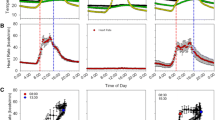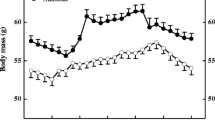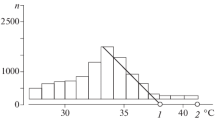Summary
Thermoregulation was studied in four species of seabirds in Ny-Ålesund, Svalbard. The major findings of the study are:
-
1.
Resting metabolic rates (RMR) were 1.64, 1.00, 1.59 and 1.11 ml O2/g·h, thermal conductance (TC) 0.0466, 0.0336, 0.0475 and 0.0282 ml O2/g·h·°C and body temperature (T b) 40.2, 38.7, 39.9 and 39.6°C, in Kittiwakes, Fulmars, Black and Brünnich's Guillemots, respectively.
-
2.
RMR values from all four species were above predicted values based on equations from Lasiewski and Dawson (1967), Aschoff and Pohl (1970) and Ellis (1984). In Kittiwakes the measured RMR values were 183%, 158% and 156% of predicted values while in Fulmars only 131%, 113% and 112%.
-
3.
Thermal conductance was lower, i.e. insulation better, in Fulmars and Brünnich's Guillemots compared to Kittiwakes and Black Guillemots. TC values obtained in this study were different from values predicted from equations of Herreid and Kessel (1967) and Aschoff (1981). While Herreid and Kessel's values were somewhat elevated, Aschoff's equation gave values below our measurements.
-
4.
Low ambient temperatures and the birds' activity level are suggested as the major reason for high RMR in Kittiwakes, Black and Brünnich's Guillemots.
-
5.
The RMR values measured in Fulmars did not differ from those of Procellariiformes studied in sub-Antarctica. It is suggested that the lower metabolic rate and body temperature enable Fulmars to survive extended periods of fasting.
Similar content being viewed by others
Abbreviations
- RMR :
-
resting metabolic rate
- TC :
-
thermal conductance
- T a :
-
ambient temperature
- T b :
-
cloacal temperature
- T c :
-
lower critical temperature
- RQ :
-
respiratory quotient
- \(V_{{\text{O}}_2 } \) :
-
oxygen consumption
References
Adams NJ, Brown CR (1984) Metabolic rates of sub-Antarctic Procellariiformes: a comparative study. Comp Biochem Physiol 77A:169–173
Aschoff J (1981) Thermal conductance in mammals and birds: Its dependence on body size and circadian phase. Comp Biochem Physiol 69A:611–619
Aschoff J, Pohl H (1970) Der Ruheumsatz von Vögeln als Fuktion der Tageszeit und der Körpergröße. J Orn 111:38–47
Bligh J, Johnson KG (1973) Glossary of terms for thermal physiology. J Appl Physiol 35:941
Butler PJ (1982) Respiration during flight and diving in birds. In: Addink ADF, Sponk N (eds) Exogenous influences on metabolic and neural control. Pergamon, Oxford, pp 103–114
Butler PJ, Woakes AJ (1982) Exercise in normally ventilating and apnoeic birds. In: Gills R (ed) Circulation, respiration, and metabolism. Springer, Berlin Heidelberg New York, pp 39–55
Croxall JP, Prince PA (1982) A preliminary assessment of the impact of seabirds on marine resources at South Georgia. Com Nat Franc Recherch Antarct 51:501–509
Drent RH, Stonehouse B (1971) Thermoregulatory responses of the Peruvian penguinSpheniscus humboldti. Comp Biochem Physiol 40A:689–710
Ellis HI (1984) Energetics of free ranging seabirds. In: Whittow GC, Rahn H (eds) Seabird energetics. Plenum Press, New York London, pp 203–234
Fedak MA, Pinshow B, Schmidt-Nielsen K (1974) Energy cost of bipedal running. Am J Physiol 227:1038–1044
Furness RW (1978) Energy requirements of seabird communities: A bioenergetics model. J Anim Ecol 47:39–53
Furness RW, Barrett RT (1985) The food requirements and ecological relationships of a seabird community in North Norway. Ornis Scand 16:305–313
Gabrielsen GW, Mehlum F, Nagy KA (1987) Daily energy expenditure and energy utilization of free ranging Blacklegged Kittiwakes (Rissa tridactyla). Condor 89:126–132
Hails CJ (1983) The metabolic rate of tropical birds. Condor 85:61–65
Herreid CF, Kessel B (1967) Thermal conductance in birds and mammals. Comp Biochem Physiol 21:405–414
Imber MJ (1976) The origin of Petrel stomach oils — a review. Condor 78:366–369
Johnson SR, West GC (1975) Growth and development of heat regulation in nestlings and metabolism in adult Common Murre and Thick-billed Murre. Ornis Scand 6:109–115
Kendeigh SC, Dol'nik VR, Gavrilov VM (1977) Avian energetics. In: Pinowski J, Kendeigh SC (eds) Granivorous birds in ecosystems. Publ Nuttall Ornith Club No 15, Cambridge, Mass.
Lasiewski RC, Dawson WR (1967) A re-examination of the relation between standard metabolic rate and body weight in birds. Condor 69:13–23
Løvenskiold HL (1964) Avifauna Svalbardensis. Norsk Polarinstitutts Skrifter 129
Masman D, Klaassen M (1987) Energy expenditure for free flight in trained and free living KestrelsFalco tinnunculus. Auk (in press)
McNab BK (1966) An analysis of body temperature of birds. Condor 68:47–55
Mortensen A, Blix AS (1985) Seasonal changes in resting metabolic rate and mass-specific conductance in Svalbard Ptarmigan, Norwegian Rock Ptarmigan and Norwegian Willow Ptarmigan. Ornis Scand 17:8–13
Prange HD, Schmidt-Nielsen K (1970) The metabolic cost of swimming in ducks. J Exp Biol 53:763–777
Prinzinger R, Hänssler I (1980) Metabolism-weight relationship in some small nonpasserine birds. Experientia 36:1299–1300
Raveling DG, LeFebvre EA (1967) Energy metabolism and theoretical flight range of birds. Bird Banding 38:97–113
Rosenheim O, Webster TA (1927) The stomach oil of the fulmar petrel (Fulmarus glacialis). Biochem J 21:11–118
Schmidt-Nielsen K (1975) Animal physiology: Adaptation and environment. Cambridge University Press
Scholander PF, Hock R, Walters V, Irving L (1950) Adaptation to cold in Arctic and tropical mammals and birds in relation to body temperature. Insulation and basal metabolic rate. Biol Bull 99:259–271
Schwan MW, Williams DD (1978) Temperature regulation in the common raven in interior Alaska. Comp Biochem Physiol 60A:31–36
Stokhan KA, Mortensen A, Blix AS (1986) Food intake, feeding rhythm and body mass regulation in Svalbard rock Ptarmigan. Am J Physiol 251:R264–266
Tucker VA (1972) Metabolism during flight in the laughing gull (Larus atricilla). Am J Physiol 222:237–245
Utter JM, LeFebvre EA (1973) Daily energy expenditure of purple martins (Progne subis) during the breeding season: estimates using D2O18 and time budget methods. Ecology 54:597–604
Warham J (1971) Body temperatures of petrels. Condor 73:214–219
Weathers WW (1979) Climate adaptation in avian standard metabolic rate. Oecologia 42:81–89
West GC (1968) Bioenergetics of captive Willow Ptarmigan under natural conditions. Ecology 49:1035–1045
West GC (1972) Seasonal differences in resting metabolic rate in Alaskan ptarmigan. Comp Biochem Physiol 42A:867–876
Wiens JA, Scott JM (1975) Model estimation of energy flow in Oregon coastal seabird populations. Condor 77:439–452
Author information
Authors and Affiliations
Rights and permissions
About this article
Cite this article
Gabrielsen, G.W., Mehlum, F. & Karlsen, H.E. Thermoregulation in four species of arctic seabirds. J Comp Physiol B 157, 703–708 (1988). https://doi.org/10.1007/BF00691000
Accepted:
Issue Date:
DOI: https://doi.org/10.1007/BF00691000




